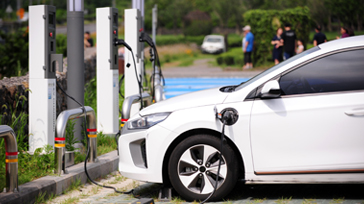Key Highlights
- President Xi's likely third term in power will be a continuation of current policies
- One of China's key opportunities going forward is its commitment to renewable energy
- On the other hand, China faces an escalation of its tech war with the US
More of the same
The Chinese Communist Party's National Congress, which kicked off on Sunday, is expected to confirm President Xi Jinping's third term in office. Back in 2018, a constitutional amendment had been passed removing presidential term limits. Given this, the world can expect a long-term continuation of the policy agenda that has marked President Xi’s leadership both at home and on the world stage.
In fact, given slower domestic growth, rising geo-political tensions and the prospect of a global recession, there is an even greater focus within China’s ruling party on the need for stability and continuity. In his opening speech, President Xi reiterated his longstanding economic priorities, including consumption-based economic growth, market-driven monetary policies, foreign investor access and turning "Chinese enterprises into world-class, globally-competitive firms".
China will continue to open up
It was noticeable however that President Xi did not spend as much time as he did in his previous Congress speech dwelling on the drivers of economic growth. While remarking on the sharp increase in China's GDP as a percentage of the world economy - from 7.2 percent to 18.5 percent over the past decade – he quickly moved on to stress the need for socialist modernisation via high quality development.
Among other things, this development involves the Chinese economy further "opening up to the outside world". President Xi stressed that China was committed to its "dual circulation" development pattern, based on domestic and foreign markets reinforcing each other.
The president also highlighted the Belt and Road initiative (BRI) as an example of China’s high quality opening up initiatives. The platform, President Xi pointed out, had led to China becoming a major trading partner to over 140 countries and regions, and a leading country for outbound investment. Alongside the high-risk loans and infrastructure funding that it has enabled to countries from Africa, Asia and the Middle East, the BRI also has technological, maritime and military dimensions.
Some analysts assess the BRI to be Beijing’s most important political and economic instrument, so it is perhaps unsurprising it gets a mention in President Xi’s speech. BRI investments have contributed to economic growth in recipient countries, including in Southeast Asia, but have also had negative social and environmental effects. It is expected that future BRI projects will be accompanied by more political and corporate governance.
Building a beautiful China
While not new, it was also notable that President Xi spent time speaking about a more sustainable China. He stressed that the conservation of nature was an essential part of building a modern socialist country and that China had already made significant advances. In his view, "Ecological and environmental protection has undergone a historical, transformational and comprehensive change - our motherland's skies are bluer, the mountains are greener and the water is clearer."
There is no ignoring the fact that China remains one of the world’s largest carbon emitters, and coal-powered power plants continue to receive funding from the government. However, the prominence given to fighting environmental degradation in President Xi’s speech suggests that this will remain a high priority issue in the years to come.
Going forward, it is anticipated that China’s transition to renewable energy production will accelerate, with state and private companies involved in the generation of solar, hydro, wind and nuclear-powered energy likely to receive much support. The consumption of renewable energy is also expected to benefit, with incentives set to grow for the purchase of electric and new energy vehicles.
As the carrot grows, so does the stick. It is anticipated that both foreign and local companies will have to comply with an ever-increasing set of green-based requirements. These include carbon quotas, ESG reporting and clean production audits. As the punishment for non-compliance grows, the more profitable firms will be the ones that are able to comply.
The intensification of US-China tech wars
In contrast to the signals from President Xi that China is keen to deepen its international engagement, the US announced an extensive set of export controls against China just a week before the National Congress. These controls aim to severely restrict China’s ability to both purchase and manufacture advanced semi-conductors. This includes the high-end chips used in the production of advanced wafers and supercomputers, whether exported to China or manufactured locally.
Chinese chipmaker stocks fell immediately following the announcement, but it is the longer term and wider impact on China’s technology ambitions that is of particular concern. There are fears that the new rules could slow China's efforts to build out its artificial intelligence and software industry, data centres, advanced hardware and other areas that are powered by supercomputers and high-end chips. Observers note that, on the positive side, these US controls are set to accelerate China’s development of its own chip industry. However, it is uncertain how quickly this can take place, especially in the absence of externally sourced advanced chip-making equipment. It is not known what, if any, retaliation the Chinese authorities are considering, and whether this will lead to a softening of the US stance over the long term.
Tentative market recovery
Looking shorter term, China’s stock market has been weak these past few quarters and could remain so for a while longer. The slowdown of the Chinese economy continues to spook investors while specific sectors, such as technology and property, have been impacted by major policy changes and restrictions.
China’s economy has also taken a beating from its zero-Covid policy. Investors had been hoping that President Xi would use the National Congress as an opportunity to announce the end of the policy. This did not happen and President Xi dug in his heels over this issue.
The slower growth is exacerbating a myriad of related issues, and leading to, for example, lower property prices and defaults among several prominent Chinese property companies. US-China geopolitical and trade tensions have only served to compound these problems, while a catalyst to revive investor interest is not yet in sight.
This publication shall not be copied or disseminated, or relied upon by any person for whatever purpose. The information herein is given on a general basis without obligation and is strictly for information only. This publication is not an offer, solicitation, recommendation or advice to buy or sell any investment product, including any collective investment schemes or shares of companies mentioned within. Although every reasonable care has been taken to ensure the accuracy and objectivity of the information contained in this publication, UOB Asset Management Ltd (“UOBAM”) and its employees shall not be held liable for any error, inaccuracy and/or omission, howsoever caused, or for any decision or action taken based on views expressed or information in this publication. The information contained in this publication, including any data, projections and underlying assumptions are based upon certain assumptions, management forecasts and analysis of information available and reflects prevailing conditions and our views as of the date of this publication, all of which are subject to change at any time without notice. Please note that the graphs, charts, formulae or other devices set out or referred to in this document cannot, in and of itself, be used to determine and will not assist any person in deciding which investment product to buy or sell, or when to buy or sell an investment product. UOBAM does not warrant the accuracy, adequacy, timeliness or completeness of the information herein for any particular purpose, and expressly disclaims liability for any error, inaccuracy or omission. Any opinion, projection and other forward-looking statement regarding future events or performance of, including but not limited to, countries, markets or companies is not necessarily indicative of, and may differ from actual events or results. Nothing in this publication constitutes accounting, legal, regulatory, tax or other advice. The information herein has no regard to the specific objectives, financial situation and particular needs of any specific person. You may wish to seek advice from a professional or an independent financial adviser about the issues discussed herein or before investing in any investment or insurance product. Should you choose not to seek such advice, you should consider carefully whether the investment or insurance product in question is suitable for you.
UOB Asset Management Ltd. Company Reg. No. 198600120Z





